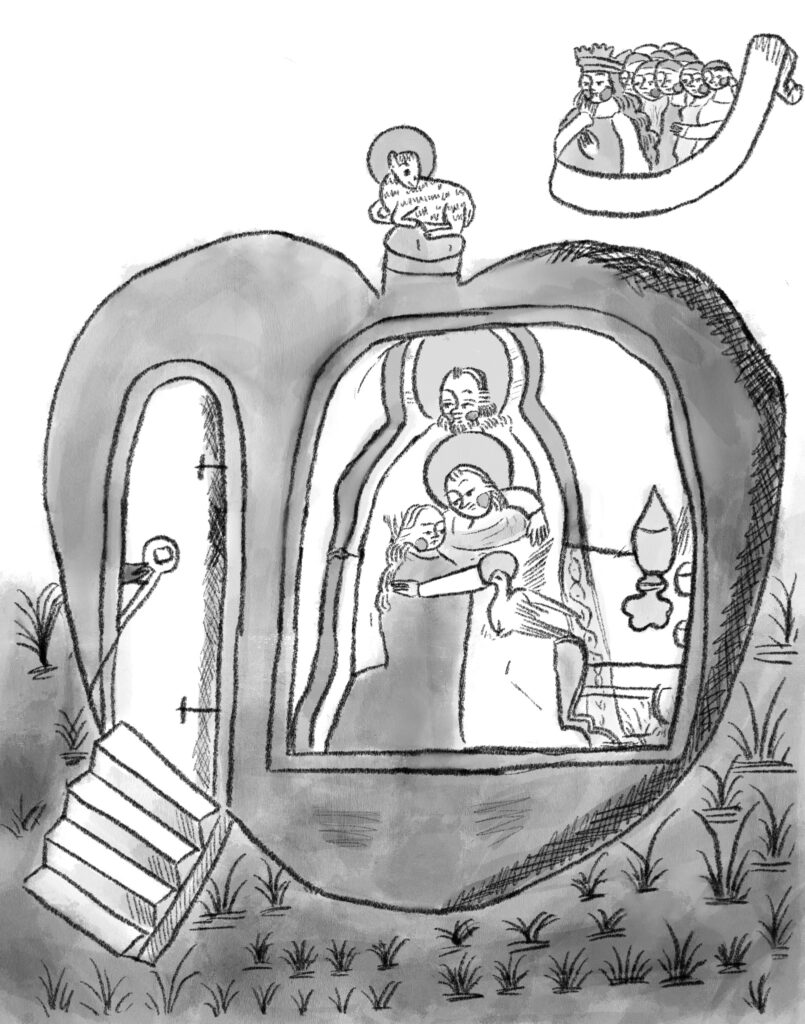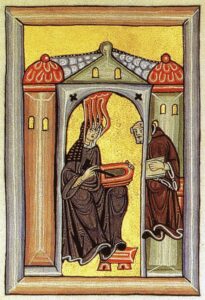hi there!
I’m so glad you’re here with me today to learn about the medieval world — and hopefully, to take a little time for yourself. Today, we’re doing two things:
- First, we’re going to learn a little about the artwork of the nuns at St. Walburga, an abbey in Germany.
- Second, we’ll look at some of the art they made.
- Finally, we’ll make some art of our own, inspired by their art.
Every activity from In Every Sense focuses on one or more specific sensory experiences — this one mostly deals with sight and vision, but we’re also going to be making art of our own, which is kinesthetic since we’ll be moving our hands and bodies to do so. You can even vary the level of touch involved in this project — while when we think about dioramas, we usually think of a shoebox diorama like the ones you made in school. But in this activity, you can do a lot of different things for your “diorama” — for example, you can make a digital “moodboard” or draw a picture instead of making a physical diorama.
If that sounds good to you, let’s dive in.
A small and gentle reminder: as always, these activities are more about how the act of creation makes you feel and less about the thing you’re making. Together, let’s try to focus more on the act of creating something new and less about whether or not it looks “good” or “right.”
part 1: learn a little
The nuns of St. Walburga didn’t consider themselves artists first and foremost. In fact, they barely considered themselves artists at all, and that’s why I think their work is so important! We can make good and important art without being “artists” in any traditional sense, and the nuns at St. Walburga certainly did.
The abbey of St. Walburga is located in what is now Bavaria, in Germany, and has existed since the 11th century — and still operates today. Many different kinds of art have been made by the nuns living there throughout its history, but one particular artist there will be of interest to us today. Sometime around 1500, a single unnamed nun there made a number of illustrations, many of which are lost to us. The ones that remain, though, are some of my favorite art done by any of the religious women of the medieval period — their style is so gentle and welcoming. They’re clearly not made by a trained artist, and they’re basically just sketches — they’re not supposed to be “high art,” and that’s OK. One of the images in these illustrations is that of a house in the shape of a heart, complete with little stairs, a door, and a window through which we can see a little family, identified as God, Jesus, and the soul, as well as a dove. Now, this nun from St. Walburg wasn’t the first person to draw a heart as a house at all — it’s a much longer religious tradition. Sometimes the heart in question is the heart of Jesus — in fact, our nun from St. Walburg has a drawing that looks very much like that, and Julian of Norwich, another one of our central religious women in this project, talks about there being a space for people inside of Jesus’ chest in her book Showings. Some of the other images, though, imagine the heart as one’s own, and as a place that’s prepared for divinity to dwell within. So, we’re placing divinity in ourselves and ourselves inside divinity. This is also not a new concept, but I think when we think about how medieval religious women like our artist at St. Walburga and like Julian of Norwich were locating devotion inside the body, and inside the heart, I think it becomes an important part of how we look at how artistic creation (a bodily experience) and spiritual thinking become intertwined.
part 2: look at some art
Here you can see an artist’s rendering of the “heart as a home” image from St. Walburga. If you’ve read some of the activities that deal with the images from Scivias, then you’ve learned that sometimes, it’s really hard to get your hands on the original images. Luckily for you, I’ve drawn a replica of sorts — although if you want to learn a little more, the original is in the Staatsbibliothek zu Berlin, Preßischer Kulturbesitz Handschriftenabteilung 417. It’s not available online for us to look at, though, unfortunately — hence our artist’s rendering here. The one big difference is that in the original, there’s a large ribbon curling around much of the house with German text on it, but I took it out for ease of seeing the image — the words aren’t particularly readable, and it’s just sort of distracting for our purposes. Take a look below, though, and think about what you learned above as you do so.

This image is particularly salient when we think about what this sort of image would have meant to nuns like our artist at St. Walburga, particularly when we contextualize this image as part of the nun’s devotional practice. Of course, if one is inviting divinity into their heart, then they would want the heart to be a nice place. This rhetoric is not out of place for the environment these women would have lived in — or even today, as we still hear phrases like “your body is a temple” to encourage ourselves towards self-improvement. If your encounter with the divine is located within your own heart, then you would want that to be a nice place — that your heart is a kind and happy place, perhaps. Let’s hold on to that as we move into envisioning what that might look like that for us.
part 3: make some art
We’re going to create together the place in our heart where we meet the object of our spiritual engagement or devotion. This might be a little weird, but bear with me as we do it — I think it’ll be a lot of fun.
So, let’s first imagine what this encounter might look like for us. What are we engaging with spiritually? Is it a deity or a religious figure? Is it something more vague, like the universe or enlightenment? Or is it a higher, better vision of ourselves? For my example, even though I am religious, I decided to think about this encounter as with the best version of myself — the most “me” version of me.
OK, so where would we want to meet this object of our spiritual engagement? When we invite them into this room, what does that room look like? Are we comfortable here? If I’m meeting my most “me” me, then I want the room to be joyful, kind, and caring. I want to carve out a really nice place for myself. Let’s picture that place together.
When you’re ready to start making your “diorama” of what that room looks like, take a moment and think about how you want to make it. On my first try, I made a board on Pinterest by searching up some images I thought would make a nice, calm environment — it doesn’t have to be a traditional elementary school shoebox diorama — even though I ended up making one of those, too. Once you’ve settled on your form (and you can certainly mix a few together!), we’ll start building our diorama of that place.
This is going to be such a personal process, and so different for every person, that I thought it might be helpful for you to hear how I went about making my diorama. I’ll use my Pinterest moodboard as an example, since that process is pretty straightforward.
First, I decided that I wanted this room to be purple. When I was little, my favorite color was a light purple, so in my head, that’s the color of my most “me” me. I searched up some light purple-colored pictures, and pulled some quotes that spoke to me, too. I ended up moving into some blues as well, but that’s OK because I like blue a lot too. I found pictures of stars, and of sand dunes, and of clouds, and of the ocean, and I put those in there — I like those things too, and they all felt really calming. I wanted this to be a really calm room, where I could meet with the most “me” me and just think my thoughts and feel my feelings. When I had all my images in one place, I looked at them all and got rid of the ones that didn’t feel like they fit in right. After all, I wanted it to be just right.
When you’re done making your room, whatever that may look like, spend some time in it. How does it feel? Would you be happy to have the encounter you imagined earlier in this space?
If so — neat! If not, tweak it until it feels right. Now, you’ve got something nice and relaxing to look at, and you’ve learned a little about yourself and what you want. It’s a question that’s worth asking — how can I make myself more like this room? How can I make my heart look the way I would want? What makes me happy? What makes me feel like I’m in touch with my beliefs? Maybe you’ve started to figure that out, just a little bit. And if you’d like to share the diorama of your heart’s room, you can head over to our gallery and submit it, or just take a look at some others from people who have done it.
Thanks for spending time with the nuns of St. Walburga, with me, and most of all, with yourself. I’ll see you next time.
If you tried out this activity, we’d love to see how it went. Click here to submit your art to our gallery.






